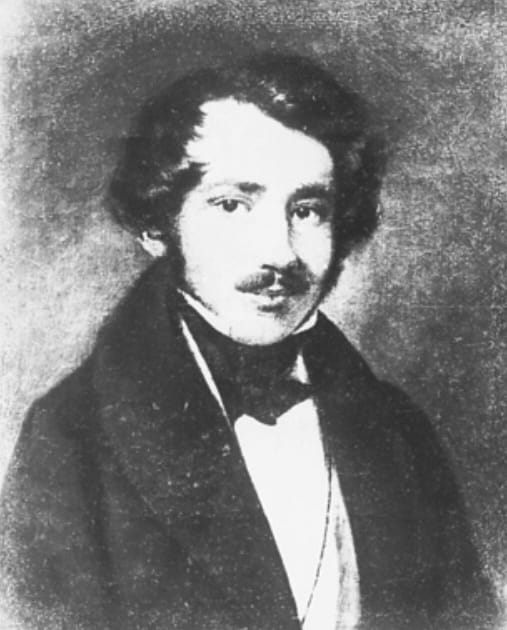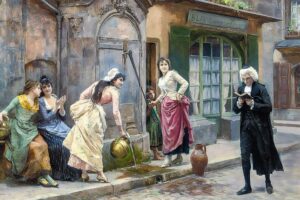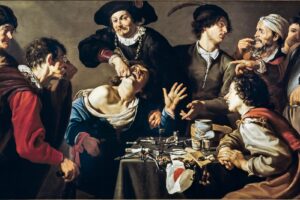A Genre Painting of Maternal Vigil, Friedrich Eduard Meyerheim, 1808–1879
Painted in the 19th century by German genre artist Friedrich Eduard Meyerheim, The Sick Daughter is a quiet portrait of care, worry, and waiting. Known for his deeply human depictions of everyday life, Meyerheim does not dramatize suffering here—he simply lets us witness it, in its most intimate, domestic form.
The Scene Before Us
The room is small and plain. Wooden floors, rough walls, a dishcloth draped over a cupboard door. A bowl and medicine bottle rest on a bench beside the bed. In that bed, a child sleeps—her face pale, her hands tucked beneath her cheek. Her illness is not named, but her weakness is clear.
Beside her, seated low, is her mother. She leans forward, forehead resting on her hand, her expression a blend of fatigue and fear. In her lap is a small prayer book, held loosely, as if she has read the same line many times without taking it in. The room holds its breath around her. Nothing stirs, not even hope.
The Deeper Meaning
This is not a painting about illness—it is about love. Meyerheim gives us the mother’s burden, the unbearable stillness of waiting, of having nothing left to do but pray. The details are modest—the shelf of plates, the tangle of cloth at her feet—but each one grounds us in the realness of their world. We know this woman, though she has no name. She is all mothers, all caretakers, all those who have sat through sleepless nights listening to a child’s faint breathing, willing it not to stop.
And yet, in her stillness, there is dignity. She is not broken. She waits because she must. She stays because she loves.
A Moment Caught in Time
This is a painting without motion, and that is its power. There is no dramatic climax, no miracle. Just this: the flickering flame of hope in the face of helplessness. The mother’s prayer, the child’s shallow sleep, the worn floor beneath her feet. Meyerheim offers us a sacred pause—a moment when life is held in uncertainty, but not without grace.
About Artist

Friedrich Eduard Meyerheim (January 7, 1808 – January 18, 1879) was a German painter known for his detailed genre scenes, primarily focused on bourgeois and peasant life. Born in Danzig (now Gdańsk, Poland), he came from a family of artists and studied at the Prussian Academy of Arts in Berlin. Meyerheim was influential in his time and became a professor and member of multiple art academies, including Berlin, Dresden, and Munich.
Artist Style and Movement
Meyerheim belonged to the Düsseldorf school of painting and worked largely in a Romantic genre style early in his career. He then devoted himself to realistic portrayals of everyday life, often focusing on rural and small-town peasants and their environment in regions like Westphalia, Thuringia, and Hesse. His work is noted for luminous enamel-like colors, detailed compositions, and a sentimental but dignified portrayal of his subjects. Meyerheim combined academic rigor with emotional depth and narrative clarity in his genre works.
Artwork Profile / Notable Works
- The Sick Daughter (Young farmer with her sick child, 1854): This poignant painting depicts a young farmer woman caring devotedly for her ailing child, capturing a tender and intimate moment filled with emotion and realistic detail. It exemplifies Meyerheim’s ability to depict the hardships and humanity of rural life with empathy.
- Westphalian Peasants Hunting Party (1836): Among his earliest major works, this painting was admired for its lively portrayal of rural festivity and was purchased for the National Gallery in Berlin.
- Village Life: Genre scenes depicting the daily activities and social customs of rural communities in Germany.
- Architectural Drawings: Meyerheim also produced numerous architectural sketches of Gothic brick buildings alongside his genre scenes, highlighting his diverse skills.
Friedrich Eduard Meyerheim’s legacy lies in his sensitive and detailed depictions of rural German life during the 19th century, combining academic technique with heartfelt narrative. His paintings provide a window into the customs, challenges, and dignity of peasant existence, securing his reputation as a key figure in German genre painting and the Düsseldorf school.



